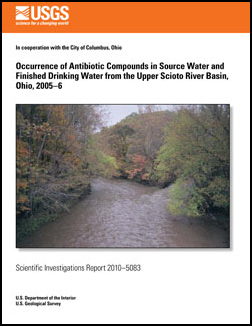Scientific Investigations Report 2010-5083
ABSTRACT
The occurrence of antibiotics in surface water and groundwater in urban basins has become a topic of increasing interest in recent years. Little is known about the occurrence, fate, or transport of these compounds and the possible health effects in humans and aquatic life. The U.S. Geological Survey, in cooperation with the City of Columbus, Division of Power and Water, did a study to provide a synoptic view of the occurrence of antibiotics in source and finished waters in the upper Scioto River Basin. Water samples were collected seasonally—winter (December 2005), spring (May 2006), summer (August 2006) and fall (October 2006)—at five surface-water sites, one groundwater site, and three water-treatment plants (WTPs). Within the upper Scioto River Basin, sampling at each WTP involved two sampling sites: a source-water intake site and a finished-water site. One or more antibiotics were detected at 11 of the 12 sampling sites. Of the 49 targeted antibiotic compounds, 12 (24 percent) were detected at least one time for a total of 61 detections overall. These compounds were azithromycin, tylosin, erythromycin-H2O, erythromycin, roxithromycin, ciprofloxacin, ofloxacin, sulfamethazine, sulfamethoxazole, iso-chlorotetracycline, lincomycin, and trimethoprim. Detection results were at low levels, with an overall median of 0.014 µg/L. Hap Cremean WTP had the fewest detections, with two source-water detections of sulfamethoxazole and azithromycin and no detections in the finished water. Of the total of 61 detections, 31 were in the winter sample run. Sulfamethoxazale and azithromycin detections represent 41 percent of all antibiotic detections. Azithromycin was detected only in the winter sample. Some antibiotics, such as those in the quinoline and tetracycline families, dissipate more quickly in warm water, which may explain why they were detected in the cool months (winter, spring, and fall) and not in the summer. Antibiotic data collected during this study were compared to antibiotic data collected in previous national, regional, and local studies. Many of the same antibiotic compounds detected in the upper Scioto River Basin also were detected in those investigations. |
First posted September 2010 For additional information contact: Part or all of this report is presented in Portable Document Format (PDF); the latest version of Adobe Reader or similar software is required to view it. Download the latest version of Adobe Reader, free of charge. |
Finnegan, D.P., Simonson, L.A., and Meyer, M.T., 2010, Occurrence of antibiotic compounds in source water and finished drinking water from the upper Scioto River Basin, Ohio, 2005–6: U.S. Geological Survey Scientific Investigations Report 2010–5083, 16 p. plus appendixes.
Acknowledgments
Abstract
Introduction
Purpose and Scope
Previous Studies
Description of Study Area
Methods
Field Methods
Quality-Control Procedures
Sample Analysis
Occurrence of Antibiotics
Suggestions for Future Investigations
References Cited
Appendix 1. Water-Quality Analyses and Quality-Control Results
Appendix 2. Sample Analysis